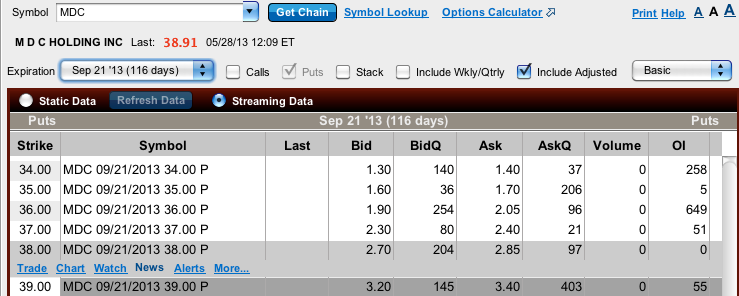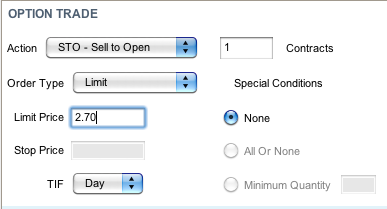There’s a low-profile, conservative trading technique that we often utilize to “get paid to wait”, for stocks that we want to take a position in.
Have you ever wanted to buy a stock, but its current price seems too high, or the market may have gotten ahead of itself? Instead of just buying this stock, consider selling put options for it.
As it turns out, the put option premiums that you can receive can often be higher than a stock’s next few dividends, even on high dividend stocks.
Here are some important principles and definitions to remember when selling options:
1. One option contract = 100 shares of the underlying stock.
2. The further out in time that you sell an option, the more money, (higher premium), you’ll get paid. Why? Because options have time value, i.e. “time is money.”
3. Put option sellers don’t receive dividends. We list dividends in our Cash Secured Puts Table so you can compare them to the put premiums.
4. Strike Price: The price you’re agreeing to buy the stock for, up until the expiration date, in return for being paid a Put Premium now.
5. Bid: The price that Put or Call buyers are willing to pay.
6. Ask: The price that Put or Call sellers are willing to sell at.
7. Many brokerage sites also list the Bid and Ask quantities, which is helpful – if there are many more bidders than sellers, you may have a chance of selling your put or call options at a higher price/premium than the current bid.
8. Volume/Open Interest: Volume is the amount of contracts which have changed hands today. Open Interest is the amount of contracts which haven’t yet expired for each call or put option. Thinly traded options have lower Open Interest.
9. Cash Reserve: This equals the amount of money that your broker will hold in your account, to ensure that you have enough funds to buy the underlying shares. This amount varies from approx. 25% up to 100%, depending on the type of account. IRAs will need a 100% cash reserve, whereas taxable accounts approved for Option Level 3 may have only 25-35% held as cash reserve per put selling trade.
TRADING EXAMPLE: To illustrate how to sell cash secured puts, let’s look at MDC Holdings (MDC), which has high options yields, and was trading at $38.91 at the time of this writing.
1. Go to the option chain for MDC, and select/find “Puts”. (Many brokers’ sites let you select puts OR calls, which makes the data less confusing.)
For each option you’ll see the Strike Price, the Last or most recent price, the Bid prices and quantities, the Ask prices and quantities, today’s Volume, and the current Open Interest (OI).
2. Look up the values for the closest months, (there’s usually a pulldown menu), to see if there are any good yields on Put strike prices below MDC’s current price. Even though there are June and July expirations, we chose the September expiration, further out in time, since it gives you a bigger put premium, (payout), which, in turn, lowers your breakeven.
3. Compare the Bids for the Strike Prices that are below the stock’s price. If you want to be more conservative, choose a lower strike price, for a lower breakeven. If you want to be more aggressive, choose a high strike price, which will pay you more, but give you a higher breakeven.
4. Compare the breakevens to the stock’s 52-week low and high, to give you an idea of its range. You can find this data on the far right side of our Cash Secured Puts Table.
5. We chose the September $38.00 put in our example. It pays $2.70, which gives you a $35.30 breakeven. Since the Bid Quantity (BidQ) is 204, and Ask Quantity (AskQ) is only 21, there’s a good chance that you may be able to sell the $28.00 put for more than $2.70.
6. Compare the upcoming dividends between now and the expiration date: Is the put bid price higher than these dividends? In some cases, it’s much higher. In our example, the Put Bid Premium is nearly 10 times MDC’s next dividend payout.
7. Look at the Put Options Yield: Our table lists all put yields as annualized because there are many different expiration dates. In this example, the Sept. $38.00 put option pays $2.70, which is a 7.1% nominal yield, for a 116-day term, which equals 22.95% annualized.
8. Cash Reserve: For each contract that you sell, your broker will reserve/hold in your account the $ needed to buy 100 shares of the underlying stock. In our example, we sold one $38.00 put, which equals $3,800.00 Cash Reserve (100 x $38.00 MDC share price).
9. Placing the Trade: Click the “Trade” link for the put option you want to sell. This should take you to a Trading module.
>1. Choose “Sell to Open” in the Action pulldown menu.
>2. Choose “Limit” in the Order Type menu.
>3. Enter your desired Selling Price in the Limit Price field.
>4. Select “Day” in the TIF pulldown menu
When you’ve made all of these entries, click the “Verify Order” button. This will bring up a summary of your order which will list the Expiration Date, the Put Strike Price, and your selling price.
Yikes! What have I gotten myself into?! In our example, we sold one September 2013 $38.00 put for MDC, which obligates us to buy 100 shares of MDC at $38.00, up until this put option’s Sept. 21, 2013 expiration date. BUT, our real cost is only $35.30, because we got paid $2.70/share, ($270.00/contract sold), for selling the put option.
After selling 1 put, you’ll receive $270.00 into your account (upon settlement in 3 days or less) for the contract you sold: (1 put corresponds to 100 shares of stock, 100 x $2.70 put premium = $270.00).
You’d have 1 of 2 outcomes at or near the expiration in September (usually options aren’t exercised or assigned until right around their expiration date):
1. Assignment: If MDC declines below $38.00, you’d be assigned (sold) 100 shares of MDC for every put contract you sold.
2. Non-Assignment: If MDC doesn’t decline to approximately $38.00 or less, your cash reserve money gets released, and you’ve made $270.00 for every contract you sold, less commissions.
In scenario 1, you’d end up owning MDC at a cost basis of $35.30, which is 10.23% lower than its current $38.91 price. There are two ways to view this outcome: Some traders would say that if you’d just waited and done nothing, you would have been able to buy it for $35.30 or even less, anyway, if the market went down.
However, you wouldn’t have had the profit opportunity that selling the put gave you, had you just waited for a market downturn. In addition, you received the put cash immediately, which you can put to use now, AND you’ve determined your potential buy price at $35.30.
Timing: Since selling puts is a conservative bullish strategy, it’s best to sell them after prices have fallen, since put prices move inversely to the market. Look for a “down” day or week when the stock is falling in price – this downward action will inflate the put premiums you can sell for, and lower your breakeven.
Disclosure: Author was short MDC put options at the time of this writing.
Disclaimer: This article was written for informational purposes only. Author not responsible for any errors, omissions, or actions taken by third parties as a result of reading this article.
- English (UK)
- English (India)
- English (Canada)
- English (Australia)
- English (South Africa)
- English (Philippines)
- English (Nigeria)
- Deutsch
- Español (España)
- Español (México)
- Français
- Italiano
- Nederlands
- Português (Portugal)
- Polski
- Português (Brasil)
- Русский
- Türkçe
- العربية
- Ελληνικά
- Svenska
- Suomi
- עברית
- 日本語
- 한국어
- 简体中文
- 繁體中文
- Bahasa Indonesia
- Bahasa Melayu
- ไทย
- Tiếng Việt
- हिंदी
How To Sell Cash Secured Puts
Published 06/05/2013, 02:18 AM
Updated 07/09/2023, 06:31 AM
How To Sell Cash Secured Puts
3rd party Ad. Not an offer or recommendation by Investing.com. See disclosure here or
remove ads
.
Latest comments
Install Our App
Risk Disclosure: Trading in financial instruments and/or cryptocurrencies involves high risks including the risk of losing some, or all, of your investment amount, and may not be suitable for all investors. Prices of cryptocurrencies are extremely volatile and may be affected by external factors such as financial, regulatory or political events. Trading on margin increases the financial risks.
Before deciding to trade in financial instrument or cryptocurrencies you should be fully informed of the risks and costs associated with trading the financial markets, carefully consider your investment objectives, level of experience, and risk appetite, and seek professional advice where needed.
Fusion Media would like to remind you that the data contained in this website is not necessarily real-time nor accurate. The data and prices on the website are not necessarily provided by any market or exchange, but may be provided by market makers, and so prices may not be accurate and may differ from the actual price at any given market, meaning prices are indicative and not appropriate for trading purposes. Fusion Media and any provider of the data contained in this website will not accept liability for any loss or damage as a result of your trading, or your reliance on the information contained within this website.
It is prohibited to use, store, reproduce, display, modify, transmit or distribute the data contained in this website without the explicit prior written permission of Fusion Media and/or the data provider. All intellectual property rights are reserved by the providers and/or the exchange providing the data contained in this website.
Fusion Media may be compensated by the advertisers that appear on the website, based on your interaction with the advertisements or advertisers.
Before deciding to trade in financial instrument or cryptocurrencies you should be fully informed of the risks and costs associated with trading the financial markets, carefully consider your investment objectives, level of experience, and risk appetite, and seek professional advice where needed.
Fusion Media would like to remind you that the data contained in this website is not necessarily real-time nor accurate. The data and prices on the website are not necessarily provided by any market or exchange, but may be provided by market makers, and so prices may not be accurate and may differ from the actual price at any given market, meaning prices are indicative and not appropriate for trading purposes. Fusion Media and any provider of the data contained in this website will not accept liability for any loss or damage as a result of your trading, or your reliance on the information contained within this website.
It is prohibited to use, store, reproduce, display, modify, transmit or distribute the data contained in this website without the explicit prior written permission of Fusion Media and/or the data provider. All intellectual property rights are reserved by the providers and/or the exchange providing the data contained in this website.
Fusion Media may be compensated by the advertisers that appear on the website, based on your interaction with the advertisements or advertisers.
© 2007-2024 - Fusion Media Limited. All Rights Reserved.
